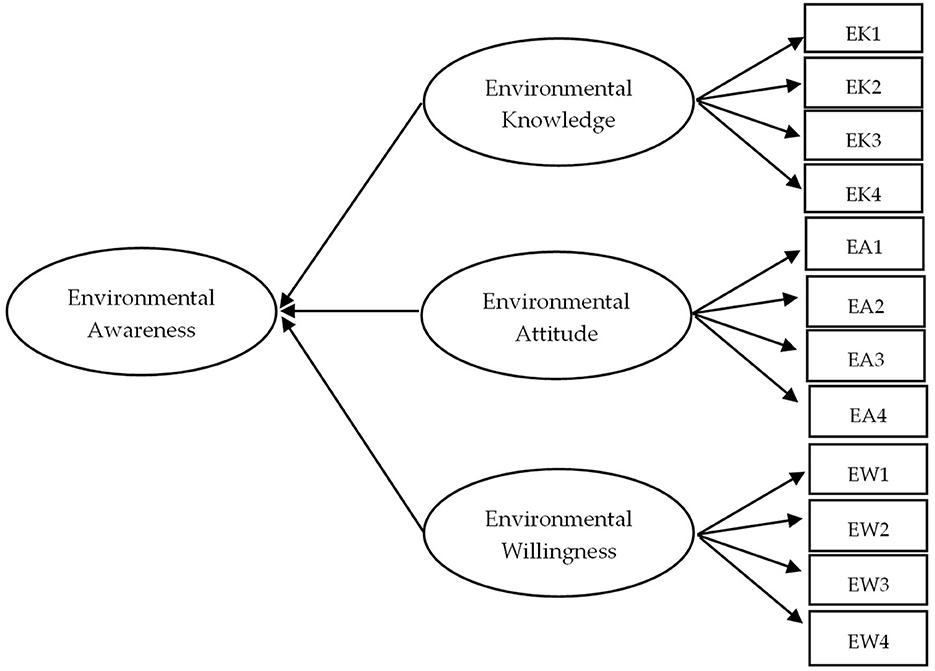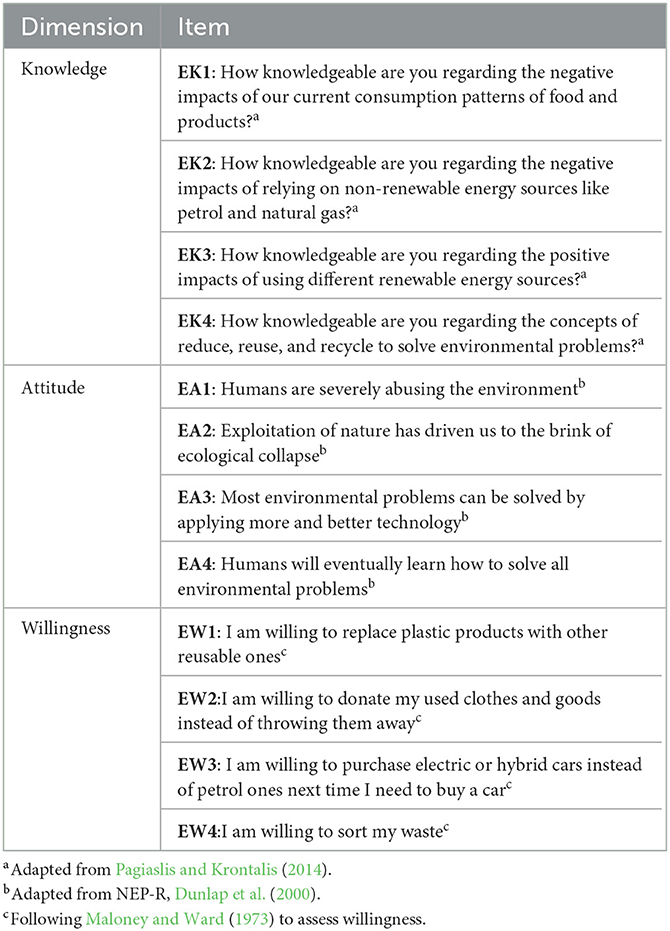- Industrial Engineering and Engineering Management Department, University of Sharjah, Sharjah, United Arab Emirates
Different sustainable technologies were used in Expo 2020 Dubai to construct the different participating pavilions. Moreover, participating countries in the Expo have presented their state-of-the-art sustainable urban planning, transportation, and energy technologies. The purpose of using and presenting these technologies was to raise the visitors' environmental awareness. Thus, this study first presents a sample of sustainable technologies that were used or presented at the Expo. It then seeks to determine if using and presenting these technologies has fulfilled the Expo goal of raising its visitors' environmental awareness. It also tries to find out which environmental dimension was raised the most. For this purpose, a questionnaire was used to measure environmental awareness before and after visiting Expo 2020 Dubai. Statistically analyzing the responses of 1,108 frequent visitors shows that Expo 2020 Dubai achieved its goal of increasing visitors' environmental awareness, particularly the environmental attitude dimension. The findings also reveal that it is essential to have a point of interest devoted to environmental issues in similar events. This positive impact on the visitors should convince upcoming mega-event planners to follow Expo 2020 Dubai's steps. However, researchers need to develop strategies to raise the willingness to act dimension of environmental awareness.
1. Introduction
Environmental awareness (Shelest et al., 2017) has been the primary motivator for people to become environmentally conscious consumers according to Sekhokoane et al. (2017). Eco-conscious consumers have pushed corporations and policymakers to adopt sustainable development solutions and policies to mitigate critical environmental problems (e.g., Ramsey et al., 1992; Bulkeley, 2000; Oğuz et al., 2010). For example, Gadenne et al. (2009) found that environmental awareness leads to environmentally friendly business practices in small and medium enterprises. Similarly, Abramova (2020) has addressed the necessity of boosting environmental awareness to create an integrated waste management system in Moscow.
Environmental awareness campaigns have been limited to a specific nation (e.g., Gadenne et al., 2009), industry (e.g., the freight transportation industry in Fu et al., 2020), or ecological component (e.g., renewable energy in Bang et al., 2000). For this reason, the Finnish-sponsored project, Strategic Guidelines for Improving Public Awareness and Environmental Education in the Baltic Sea Area, targeted all Baltic Sea catchment area countries because ecological systems are not confined to a single country (Partanen-Hertell et al., 1999).
Mega-events like Expos and World Cups provide ideal opportunities to raise environmental awareness across all age groups, geographies, and cultures. These events are great opportunities to raise public awareness about the Sustainable Development Goals of the United Nations (World Health Organization, 2016). Sustainability is one of the three key objectives of Expo 2020 Dubai. Sustainability can be defined as meeting the needs of the present without compromising the ability of future generations to meet their own needs.
The four key sustainability objectives of Expo 2020 Dubai, hereafter referred to as Expo, are 1:
1. Leaving a legacy of sustainable infrastructure and future-oriented sustainable practices.
2. Catalyzing sustainability efforts in Dubai and the UAE.
3. Increasing public awareness by engaging society on sustainability principles and sustainable living.
4. Developing sustainability solutions that are scalable, extending their benefits to the wider economy.
Sustainability is a broad phrase that encompasses economic, social, and environmental factors. This study will focus on environmental sustainability and investigate whether the Expo achieved its goal of increasing the environmental awareness of its attendees. Formally, this research aims to answer the following question:
RQ1: Did Expo 2020 Dubai raise the environmental awareness of its visitors?
As explained later, environmental awareness has several dimensions: knowledge, attitude, and willingness (Fu et al., 2020). Consequently, the next natural question to ask after addressing RQ1 is:
RQ2: Which environmental awareness component was raised the most due to visiting the Expo?
A quantitative research technique based on a survey targeting Expo 2020 Dubai visitors are used to answer these questions. The survey measures visitors' environmental awareness before and after visiting the Expo, where environmental awareness is a multidimensional construct (Sarstedt et al., 2019). To the authors' knowledge, the extant literature did not address these questions about previous mega-events. In addition to answering the above two questions, this research also sheds light on the different sustainable technologies presented at the Expo.
2. Expo 2020 Dubai
The 182-day Expo 2020 Dubai's theme is “connecting minds, creating the future” (EXPO 2020 DUBAI UAE, 2021a), which is based on the idea that bringing the world together could result in a twist of new perspectives, actions, and inspirations to establish solutions to challenges facing the whole world. Expo 2020 Dubai is divided into three thematic districts: sustainability, transportation, and opportunity, where 192 countries participating in the Expo have their own pavilion. There are additional pavilions for national and international organizations and organizations sponsoring the event.
Terra, the sustainability pavilion, is a unique pavilion that focuses on environmental issues and solutions, with giant solar panel-clad e-trees and 100% water recycling. In the following, a more detailed description of Terra is provided, then, five country pavilions that are likewise concerned with environmental issues are described.
2.1. Terra—The sustainability pavilion
Under the heading “What to Expect When Visiting the Terra Pavilion,” the official Expo's website (EXPO 2020 DUBAI UAE, 2021b) highlights the following items:
• Be inspired to fight climate change.
• Solar energy and lots of it.
• Smart use of water.
• New paths of sustainability.
Terra consists of 4,192 mono-crystalline photovoltaic cells mounted on a 130-m wide-angled, oval-shaped smart canopy following the sun-like sunflowers and 18 Energy Trees scattered around the pavilion, as shown in Figure 1. It can generate up to 4 GWh of electricity per year, sufficient to power the energy consumption of 370 average households. Besides being a smart roof system for electricity generation and creating a thermally isolated underground exhibition space, the main canopy also helps collect rainwater and dew at night to produce clean water and recycle graywater.

Figure 1. Terra pavilion photo. Source: Expo 2020 Dubai official website: https://www.expo2020dubai.com/en.
The Terra display has two immersive tracks for guests to choose from: one exhibits the vivid secret world beneath the forest, as shown in Figure 2, whereas the other shows the fully diversified life beneath the sea, as shown in Figure 3. Following these trails, visitors are confronted with the sad reality that people are harming the lives of other creatures as a result of their actions.The dissolving theater display as shown in Figure 4, for example, depicts how ocean acidification and warming, both of which are the result of human-caused environmental degradation, will harm sea animals. Figure 5 shows the gnasher production machine. The gnasher uses nature as an input and produces items as an output. The gnasher also depicts the enormous amount of goods that are produced but not consumed. After comprehending how human activities degrade two rich ecosystems, the exhibition offers realistic, sustainable solutions from several countries.
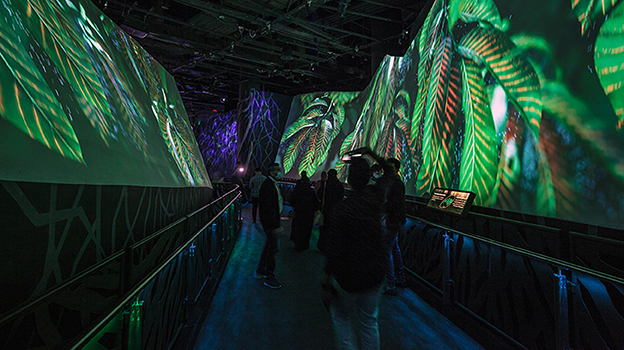
Figure 2. Under the forest track. Source: Thinc design website: https://www.thincdesign.com/project/sustainability-pavilion-expo-2020.
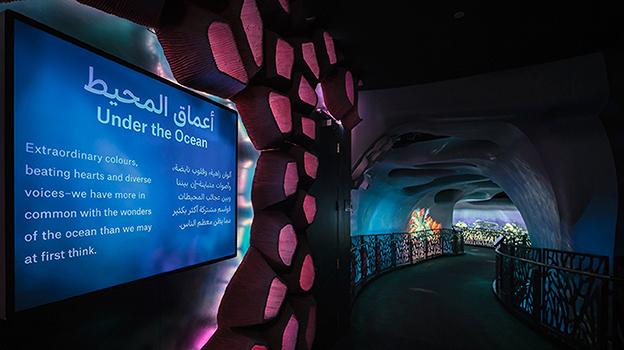
Figure 3. Deep ocean life track. Source: Thinc design website: https://www.thincdesign.com/project/sustainability-pavilion-expo-2020.

Figure 4. Dissolving theater. Source: Thinc design website: https://www.thincdesign.com/project/sustainability-pavilion-expo-2020.

Figure 5. The gnasher. Source: Thinc design website: https://www.thincdesign.com/project/sustainability-pavilion-expo-2020.
2.2. Country-pavilions
The Terra pavilion targeted environmental issues as well as potential remedies. On the other hand, the pavilions of the countries were more concerned with sustainable solutions. Both the pavilions' constructions and exhibitions featured these solutions. This section overviews five country pavilions where sustainable solutions were prioritized. These pavilions were chosen using a peer-to-peer voting procedure. Staff from thirty country pavilions were asked to recommend five pavilions, other than their own, that focused on sustainability. This section gives snapshots of Germany, Italy, Spain, Singapore, and the Netherlands' pavilions.
2.2.1. Pavilions' constructions
The pavilions employed a variety of environmentally friendly, architectural, and technological construction techniques. Some illustrations of these techniques are as follows:
1. Reducing energy consumption.
(a) Having canopies as rooftops to reduce cooling requirements, e.g., Singapore pavilion.
(b) Thermally insulating the exhibitions by adopting canonical-shape structures, e.g., Spain and the Netherlands pavilions.
(c) Vertically stacking structures to minimize exposure to sun, e.g., stacking the three labs in the German pavilion.
(d) Using greenery to keep the temperature down, e.g., Singapore pavilion.
(e) Creating a technical cloud to allow light to penetrate the roof but to reduce direct sunlight impact, e.g., German pavilion.
(f) Locating exhibitions underground, e.g., the Netherlands and Spain pavilions.
(g) Generating own energy using solar panels, e.g., Singapore and Spain pavilions.
2. Reducing water consumption.
(a) Using sensors and robots to optimize the amount of water needed for irrigation, e.g., Singapore pavilion.
(b) Using drip irrigation techniques, e.g., Singapore pavilion.
3. Generating own water.
(a) Condensing moisture to produce fresh water, e.g., the Netherlands pavilion.
(b) Generating water through a desalination plant powered by solar energy, e.g., Singapore pavilion.
4. Reducing materials needed for construction.
(a) Using Ethylene Tetraflouroethlyne (ETFE) for roofs to reduce steel needed in construction, e.g., Italy pavilion.
(b) Enclosing the building with trees and plants instead of walls, e.g., Singapore pavilion.
(c) Replacing walls with ropes made from recycled plastic, e.g., Italy pavilion.
5. Reusing materials.
(a) Using old materials in the structure, e.g., using old pipes for the walls of the Netherlands pavilion.
(b) Using reusable materials in all pavilions.
6. Creating natural environments.
(a) Creating a biotope, an area of uniform environmental conditions providing a living place for a specific assemblage of plants and animals, e.g., the Netherlands pavilion.
(b) Creating a rain forest in the middle of the desert, e.g., Singapore pavilion.
2.2.2. Pavilions' exhibitions
The pavilions' exhibitions used a variety of approaches to promote environmental awareness. We briefly describe their approaches:
1. Italy. The Italian exhibition is following the pavilion's theme of “Beauty connects people.” The pavilion has a 17-foot, 3D-printed reproduction of Michelangelo's famed David monument, as well as various other cultural and historical displays, with 160 flora species adorning the walks and walkways inside. Furthermore, the expo showcases a number of innovative Italian technologies that support circular economies and propose answers to environmental concerns.
2. Germany. Being a campus, the pavilion has three labs: the energy lab, the future city Lab and the biodiversity lab. In each lab, cutting-edge German sustainable technologies are presented. According to the pavilion's official website, “Our aim in Dubai is to show that, rather than only having a destructive impact on our planet, humankind has the capacity—thanks to its intelligence and creativity—to put global development back on a positive course if, as the Expo theme suggests, people join forces.” Visitors to the pavilion can learn about energy, smart cities, and biodiversity by visiting the three labs. Visitors are supposed to raise their environmental awareness at these labs through various communication channels such as interactive experiments, movies, and exhibits. A group of visitors swings in a vast room toward the end of the exhibition to demonstrate how we can transform our surroundings by working together.
3. Singapore. Singapore's vision is to become a city in nature, and the exhibition is proof of that. Visitors to the pavilions enter through the ground garden that soothes the senses through the cool air, proper sunshine, and abundance of greenery. Visitors then watch a 360-degree, panoramic display in the city cone that presents challenges faced in large cities and how Singapore was able to defeat these challenges to become a city in nature. In addition to the city cone, the pavilion has rainforest and flower cones. On the one hand, the center piece of the rainforest cone is a mimic of the giant Dipterocarp tree's two-wing fruits that spin down during the fruiting season. On the other hand, the flower cone presents Singapore's orchid hybridization and conservation.
4. Spain. The exhibition's centerpiece, the Forest of Intelligence, is kept underground to save on cooling costs. The fake forest trees are made of special materials and can absorb CO2 and other greenhouse gases in the same manner that real trees can. Microalgae produced specifically for the pavilion also enhance oxygen levels, reduce global warming, can minimize future climate change effects, and are used to make biofuels and protein-rich diets. Other innovations concerning circular economies and closed-loop supply networks are also presented.
5. Netherlands. Through an immersive and engaging experience, visitors to the pavilion can learn about the biotope. A short film demonstrating how the biotope works are displayed on umbrellas handed to guests inside the cone. Waterfalls like rain from the top of the cone at the end of the 3-min show.
3. Environmental awareness and expos
This section starts by reviewing the literature on measuring environmental awareness. It then reviews publications about mega-events and sustainability. Finally, this section ends by showing the new contributions of this paper and its importance relative to previous studies and future mega-events.
3.1. Measuring environmental awareness
Although environmental awareness as a construct was first used over 50 years ago, experts have no consensus about measuring it (Fu et al., 2020). However, scholars (e.g., Maloney and Ward, 1973; Dembkowski and Hanmer-Lloyd, 1994) have accepted that environmental awareness is a higher-order construct (HOC). The environmental awareness construct is formed from Cognitive (e.g., knowledge), affective (e.g., attitudes), and conative (e.g., behavioral intentions or willingness) constructs (e.g., Maloney and Ward, 1973; Maloney et al., 1975; Kollmuss and Agyeman, 2002; Zsóka, 2008; Zsóka et al., 2013). Several researchers (Kollmuss and Agyeman, 2002; Zsóka et al., 2013) have also included environmental concern (EC) in the environmental awareness construct, while others considered EC as part of the environmental attitude (Dunlap and Jones, 2002). The questionnaire used in this work assumes a three-dimensional construct to measure environmental awareness similar to that used by earlier researchers. Thus, the questionnaire operationalizes and measures the lower-order constructs (LOCs) of knowledge, attitude, and willingness.
Environmental knowledge affects a person's thinking, values, attitudes, and behavior toward environmental issues (Dembkowski and Hanmer-Lloyd, 1994). Fryxell and Lo (2003) defines environmental knowledge as “knowledge of facts, concepts, and relationships concerning the natural environment and its major ecosystems.” Zsóka et al. (2013) extended this definition such that environmental knowledge is not only about knowing environmental problems but also about knowing the solutions to these problems.
Environmental knowledge can be divided into objective and subjective knowledge (e.g., Maloney et al., 1975; Pagiaslis and Krontalis, 2014). On the one hand, objective knowledge measures the extent of accurate information about the environment and its problems stored in an individual's long-term memory (Vicente-Molina et al., 2013). On the other hand, subjective knowledge measures what or how much a person knows about specific pro-environmental actions (Pagiaslis and Krontalis, 2014). Researchers typically rely on either type of knowledge when measuring environmental Awareness (Vicente-Molina et al., 2013). It is argued in Pagiaslis and Krontalis (2014) and Fu et al. (2020) that measuring subjective environmental knowledge is more suitable for studies that measure the effects of environmental awareness on pro-environmental behavior.
The second LOC that measures environmental awareness is attitude. Attitude generally concerns a person's belief regarding the consequences of undertaking a specific behavior as a function of the person's valuation of the consequences (Ajzen, 1991). According to Milfont and Duckitt (2010), environmental attitude “is a psychological tendency expressed by evaluating the natural environment with some degree of favor or disfavor.”
Willingness to act is the third LOC needed to measure environmental awareness. According to Stone et al. (1995), willingness to act defines behavioral intentions that are assumed to capture the motivational factors that influence a given behavior (Ajzen, 1991). Maloney et al. (1975) measures willingness by measuring the verbal commitment to act.
3.2. Environmental awareness and expos
Multiple scholars have investigated the influence of mega-events on environmental perspectives. Hao et al. (2011) and Deng et al. (2014) analyzed the effects of Expo 2010 on the air quality of Shanghai, China. Deng et al. (2014) investigated how effective planning would improve urban life in the city, while Hao et al. (2011) analyzed how Expo 2010 affected the air quality of Shanghai. Regarding Expo 2015 Milan, Guizzardi et al. (2017), and Prayag et al. (2021) investigated the impact of environmental certification on Milan's residents, not the visitors.
3.3. Gaps and contributions
Previous research on Expos and environmental concerns focused solely on the environmental effects of the Expos on the host cities, such as urban planning and air quality. These studies did not study how these events have affected their visitors. Thus, it is essential to determine whether or not these mega-events achieve their goals of raising the environmental awareness of visitors.
This paper also documents the tools used to raise environmental awareness. These tools are not limited to exhibitions and showcases but also the pavilions' constructions. The effect of employing construction to raise environmental awareness was not tested before.
4. Research design
This study's sample consists of Expo attendees who purchased annual passes. In this research, an identical questionnaire was administered twice, before and after the Expo. Comparing the findings of the two surveys would provide an answer to the study's research questions.
All annual pass purchasers must register their phone numbers and email addresses with the Expo administration. A random sample of 1,500 visitors out of approximately 300,000 individuals who bought the annual passes was contacted. From this sample, 1,240 individuals volunteered to complete the questionnaire. Although 1,240 people completed the questionnaire before the Expo, only 1,108 responses were received after the Expo. The pre-visit and post-visit surveys were administered 1 week before and after the Expo. Participants received electronic surveys, followed by phone calls to answer any questions and urge them to complete the surveys.
The questionnaire consisted of two sections. The first section addressed (i) general demographic questions and (ii) pavilion visits. Questions assessing the LOCs of environmental awareness were asked in the second section. The questionnaire's second section was identical before and after the Expo. However, questions regarding pavilion visits were not included in the first survey.
4.1. Environmental awareness
Since the Expo had two goals: (i) to shed light on environmental problems and (ii) to demonstrate that there are solutions to these problems, both goals were assessed through the survey questions. So, the survey included two questions about environmental problems and two other questions about solutions to environmental problems when assessing knowledge and attitude (Zsóka et al., 2013). All questions were adopted from the literature, possibly slightly modified, to avoid deviating from the literature, and still serve the purpose of this study. As illustrated in Figure 6, a reflective-formative HOC to assess awareness is used.
Questions EK1-EK4 in Table 1 are comparable to those in Pagiaslis and Krontalis (2014). Pagiaslis and Krontalis (2014) focused on biofuels; hence, they evaluated the consequences of pollution and how biofuels might resolve these issues. However, this study is not concentrating on a single environmental problem and its solution; hence, the questions adopted from Pagiaslis and Krontalis (2014) were modified to make them more suitable to the information presented in the key pavilions. As previously indicated, questions EK1 and EK2 test the environmental knowledge of visitors regarding environmental problems, whereas questions EK3 and K4 assess their environmental knowledge regarding solutions to these problems.
Dunlap et al. (2000) have created a set of environmental attitude-measuring questions, the revised new ecological paradigm (NEP-R) (Milfont and Duckitt, 2010), from which four questions are selected. Questions EA1 and EA2 in Table 1 inquire about the severity of environmental problems. The remaining two questions, EA3 and EA4, address potential fixes to the challenges. The verbal commitment subscale created by Maloney et al. (1975) examines what a person is willing to do about environmental issues, such as sorting rubbish or using public transportation. Questions EW1–EW4 in Table 1 assess willingness to follow the guidelines in Maloney et al. (1975). Moreover, these issues are compatible with what the respondents have experienced in the Expo.
4.2. Questionnaire validation
Before collecting data, the questionnaire was validated using the procedures described by Bang et al. (2000). Seven professionals in the field assessed the questionnaire, one of whom has peer-reviewed articles on environmental awareness assessments. Face validation of the questionnaire and recommendations for question revisions were solicited. The questionnaire was then administered to twenty individuals who were questioned about the questions' clarity and ambiguity. Before sending the questionnaire to the respondents, questions were adjusted based on the inputs received from experts and the pilot test. The replies were measured using a five-point Likert scale, with responses matching the question type.
5. Data analysis
In this section, the gathered data were initially evaluated for reliability and validity. Then, two hypotheses are used to answer RQ1 and RQ2. Last, a series of statistical tests were conducted to assess whether demographic data or Expo attendance affects raising environmental awareness.
5.1. Reliability and validity
The LOCs in our model are reflective because the used indicators are manifestations of these constructs; however, environmental awareness is a formative construct because each LOC defines one of its facets. This distinction in causation between reflective and formative notions requires distinct methods for assessing their reliability and validity (e.g., Hair et al., 2011, 2012; Sarstedt et al., 2019).
The values of Cronbach's alpha(α), composite reliability (CR), and average variance extracted (AVE) are presented in Table 2 for the LOCs before and after attending the Expo. Cronbach(α) and CR values over 0.7, according to Cronbach (1951) and Hair et al. (2011), respectively, indicate internal consistency. Table 2 demonstrates that all LOCs surpass these threshold values in surveys done before and following the Expo. In addition to internal consistency, indicator reliability is approved if the indicator loading associated with each question exceeds 0.6, as discussed by Chin (1998) and Henseler et al. (2009). Before and after the Expo, the lowest indicator loading in both models was 0.646%. Thus, the LOCs are deemed reliable.
AVE must be more than 0.5 to establish convergent validity, as mentioned in Fornell and Larcker (1981). Table 2 demonstrates that all LOCs have met this criterion. According to Fornell and Larcker (1981), the Fornell–Larcker criterion for evaluating discriminant validity demands that the AVE of each concept be greater than the squared correlations with all other constructs. This relation holds for all LOCs in both models.
In our approach, the LOCs serve as environmental awareness indicators, a formative HOC. Petter et al. (2007) suggest that examining the reliability of formative constructs is not essential because each dimension assesses a different aspect of the construct. Consequently, the significance of each LOC on the HOC and the relationship between LOCs are evaluated (Henseler et al., 2009). The relevance of each LOC is determined by comparing the weights of the indicators to a threshold value of 0.1 (Andreev et al., 2009), where a bootstrapping approach determines the weights (Henseler et al., 2009; Hair et al., 2011). Table 3 demonstrates that all weights surpass 0.1 and are statistically significant based on the P-values associated with each LOC. Table 3 also displays variance inflation factors (VIFs) employed to quantify the degree of multicollinearity between the indicators (Hair et al., 2011). According to Diamantopoulos and Siguaw (2006) and Hair et al. (2011), indicators are deemed independent if their VIF values are less than 5 or 3.3, respectively. In our models, the VIF values are less than 3.3.
5.2. Answering the research questions
Each research question is associated with an appropriate hypothesis. Conclusions made from testing these hypotheses answer RQ1 and RQ2. Since measures are taken before and after visiting the Expo for the same individuals, paired tests are used to examine the differences in environmental awareness before and after the Expo. Wilcoxon-signed-rank test (Taheri and Hesamian, 2013) is used to answer RQ1, which is associated with Hypothesis 1, where and are the population medians of environmental awareness before and after the Expo, respectively. The Wilcoxon-signed-rank test is non-parametric and is more appropriate for hypothesis resulting from Likert-scale data, which could violate the assumptions of normality needed to use parametric testing (Carifio and Perla, 2008; De Winter and Dodou, 2010).
Hypothesis 1:
H0:
HA:
In addition to testing environmental awareness before and after the Expo, the three LOCs are also tested, as shown in Hypothesis 2. In this hypothesis, q refers to one of the three LOCs components used to measure environmental awareness.
Hypothesis 2:
H0:
HA:
Using a confidence level of 0.01, i.e., α = 0.01, the four null hypotheses are rejected because the P-values for all the tests are less than 0.01. Thus, it is concluded that environmental awareness and all its dimensions were raised after visiting the Expo.
RQ2 is about identifying the environmental awareness component that was most increased because of Expo attendance. As shown in Hypotheses 3A-5B, six tests are conducted to rank the environmental awareness components based on how much they were raised. The null hypotheses assume the equality of the median changes, while the alternative, one-sided hypotheses check which of the tested components has been raised more. The Δμcomponent represents the change in medians of the environmental awareness of the tested component. By component, we mean the three LOCs of knowledge, attitude, and willingness.
Hypothesis 3A:
H0: [HA:]
HA:
Hypothesis 3B:
H0:
HA:
Hypothesis 4A:
H0:
HA:
Hypothesis 4B:
H0:
HA:
Hypothesis 5A:
H0:
HA:
Hypothesis 5B:
H0:
HA:
The P-value of hypothesis 3A is almost 1, while it is < 0.01 for hypothesis 3B. Thus, it is concluded that environmental attitude has been raised more than environmental knowledge. Hypotheses 4A and 4B conclusions show that environmental knowledge has increased more than environmental willingness, while Hypotheses 5A and 5B conclusions show that environmental attitude has increased more than environmental willingness. Consequently, the results of these three hypotheses show that environmental attitude was raised the most, followed by environmental knowledge and environmental willingness.
Table 4 highlights the respondents' demographic information. It also provides information regarding the number of pavilions visited by respondents and statistics regarding the Terra pavilion visits. Table 4 shows the gender neutrality of our sample since 52% of respondents are male, and 48% are female. However, the sample was biased in terms of age and education. Most respondents are 18–35 years old and hold bachelor's degrees. The Terra pavilion was visited by 84% of the survey respondents. Respondents are clustered into various groups based on the criteria indicated in column 1 of Table 4. Last, respondents came from 84 different counties; consequently, nationality is excluded from any further analysis.
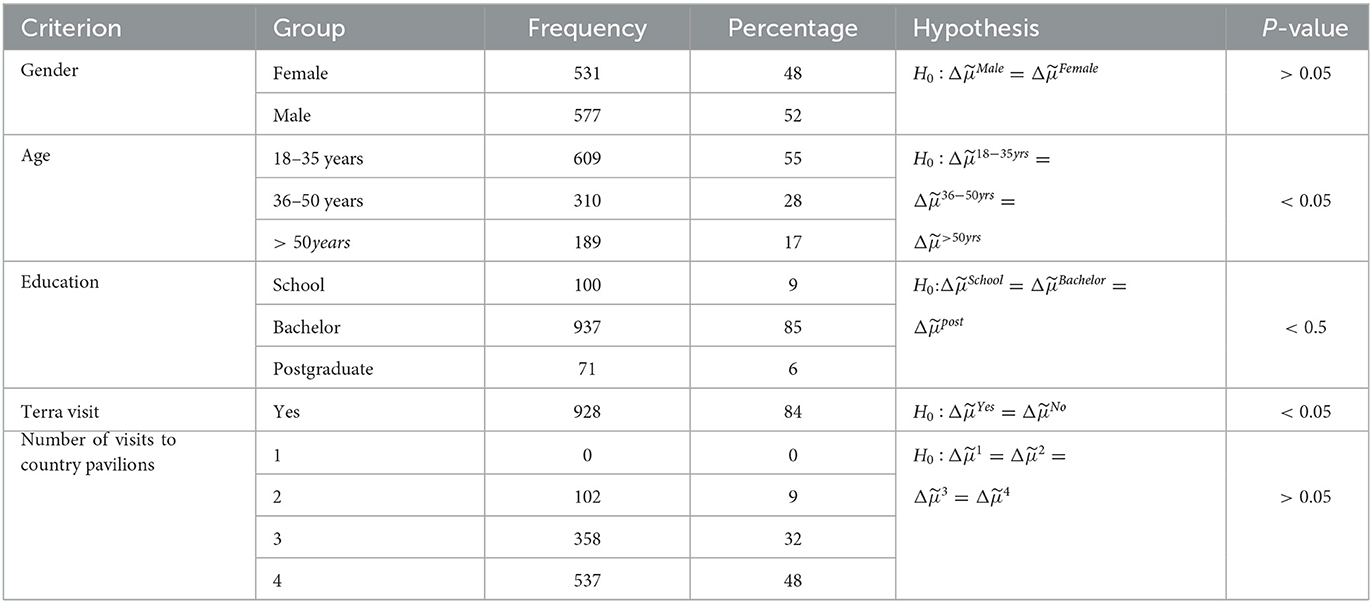
Table 4. Test-of-hypothesis about the change in environmental awareness for the different groups that visited the expo.
5.3. Demographic effects
Table 4 displays the results of five hypotheses tests to determine whether Expo attendance had an equivalent impact on all groups within each criterion. The tested hypotheses are shown in column 5 of Table 4, while the p-values of each test are shown in column 6 of Table 4. The Kruskal–Wallis test, the non-parametric version of the analysis of variance (ANOVA) test, is used. It is evident from the analysis that gender did not influence how much environmental awareness was raised. Similarly, the frequency of trips to the country pavilion did not affect environmental awareness, as seen by the p-value of the last hypothesis. The reason behind the high p-value of the last hypothesis is: (1) the majority of visitors, 84%, have visited Terra, and (2) all respondents have visited at least one of the listed pavilions.
Visiting Terra undoubtedly increased visitors' awareness since the fourth hypothesis in Table 4 was rejected. This significant outcome demonstrates the need for a dedicated pavilion to highlight environmental issues and their solutions. Furthermore, different age groups were affected differently regarding their environmental awareness. Young visitors' environmental awareness increased significantly, whereas middle-aged visitors' environmental awareness increased the least. Lastly, education affected the visitors' environmental awareness. Visitors with advanced degrees experienced the greatest increase in environmental awareness, followed by those with high school education.
6. Conclusion and future work
This study examined whether a global mega-event such as the Dubai 2020 Expo could increase environmental awareness among eventgoers, given that sustainability is one of the Expo's goals. Participating pavilions in the Expo have either used sustainable technologies in construction or presented sustainable technologies used in domains like energy and transportation. In this research, a survey was administered to determine if the Expo had raised visitors' environmental awareness. Through the same survey, the most boosted environmental awareness aspect was identified.
Environmental awareness of a sample of 1,108 Expo attendees was measured before and after the Expo. Results show that visiting the Expo has raised the environmental awareness of the sample group. Moreover, among the three environmental awareness components, the Expo's visits increased environmental attitude more than knowledge and willingness. The results also indicate that a pavilion devoted to environmental issues and their solutions, like the Terra pavilion, undeniably boosts environmental awareness.
Every major event should aim to raise environmental awareness, particularly in light of the Dubai 2020 Expo's success in this area. As environmental knowledge and attitude increased more than environmental willingness due to the Expo, researchers, event planners, and mega-event participants must devise new strategies to promote environmental willingness.
Researchers must assemble, review, and contrast the tools used to raise environmental awareness in mega-events so that decision-makers can choose the best for future events. Moreover, organizations granting the rights for countries to host these mega-events need to consider what hosting countries can do to raise environmental awareness.
Data availability statement
The raw data supporting the conclusions of this article will be made available by the authors, without undue reservation.
Ethics statement
Ethical review and approval was not required for the study on human participants in accordance with the local legislation and institutional requirements. Written informed consent for participation was not required for this study in accordance with the national legislation and the institutional requirements.
Author contributions
SA-S and RA did the conceptualization of this article and data analysis. AH-A and AA provided support in doing an extensive literature review and data collection prior to the compilation of the article by RA. All authors contributed to the article and approved the submitted version.
Acknowledgments
We are grateful to the anonymous respondents for their impartial participation in the survey process. We also wish to thank all experts who face validated the questionnaire and recommended changes. We are grateful to Thinc Design for allowing us to use their photos.
Conflict of interest
The authors declare that the research was conducted in the absence of any commercial or financial relationships that could be construed as a potential conflict of interest.
Publisher's note
All claims expressed in this article are solely those of the authors and do not necessarily represent those of their affiliated organizations, or those of the publisher, the editors and the reviewers. Any product that may be evaluated in this article, or claim that may be made by its manufacturer, is not guaranteed or endorsed by the publisher.
Footnotes
1. ^https://www.expo2020dubai.com/-/media/expo2020/sustainability/expo2020-sustainability-report-2019-en.pdf
References
Abramova, N. (2020). “Raising environmental awareness as a meaningful factor of integrated waste management in Moscow,” in E3S Web of Conferences, Vol. 217 (EDP Sciences), 04012. doi: 10.1051/e3sconf/202021704012
Andreev, P., Heart, T., Maoz, H., and Pliskin, N. (2009). “Validating formative partial least squares (PLS) models: methodological review and empirical illustration,” in Proceedings of the International Conference on Information Systems, ICIS 2009 (Phoenix, AZ).
Bang, H.-K., Ellinger, A. E., Hadjimarcou, J., and Traichal, P. A. (2000). Consumer concern, knowledge, belief, and attitude toward renewable energy: an application of the reasoned action theory. Psychol. Market. 17, 449–468. doi: 10.1002/(SICI)1520-6793(200006)17:6<449::AID-MAR2>3.0.CO;2-8
Bulkeley, H. (2000). Common knowledge? public understanding of climate change in Newcastle, Australia. Public Understand. Sci. 9, 313. doi: 10.1177/096366250000900301
Carifio, J., and Perla, R. (2008). Resolving the 50-year debate around using and misusing likert scales. Med. Educ. 42, 1150–1152. doi: 10.1111/j.1365-2923.2008.03172.x
Chin, W. W. (1998). Commentary: issues and opinion on structural equation modeling. MIS Q. 22, 7–17.
Cronbach, L. J. (1951). Coefficient alpha and the internal structure of tests. Psychometrika 16, 297–334.
De Winter, J. C., and Dodou, D. (2010). Five-point likert items: t test versus Mann-Whitney-Wilcoxon. Pract. Assess. Res. Eval. 15, 1–12. doi: 10.7275/bj1p-ts64
Dembkowski, S., and Hanmer-Lloyd, S. (1994). The environmental value-attitude-system model: a framework to guide the understanding of environmentally-conscious consumer behaviour. J. Market. Manage. 10, 593–603.
Deng, Y., Poon, S., and Chan, H. (2014). Synergising functional and environmental planning for mega-event led urban renewals and beyond: lessons from the Expo 2010 Shanghai China. Int. Plan. Stud. 19, 244–267. doi: 10.1080/13563475.2014.894473
Diamantopoulos, A., and Siguaw, J. A. (2006). Formative versus reflective indicators in organizational measure development: a comparison and empirical illustration. Brit. J. Manage. 17, 263–282. doi: 10.1111/j.1467-8551.2006.00500.x
Dunlap, R. E., and Jones, R. E. (2002). Environmental concern: conceptual and measurement issues. Handb. Environ. Zociol. 3, 482–524.
Dunlap, R. E., Van Liere, K. D., Mertig, A. G., and Jones, R. E. (2000). New trends in measuring environmental attitudes: measuring endorsement of the new ecological paradigm: a revised NEP scale. J. Soc. Issues 56, 425–442. doi: 10.1111/0022-4537.00176
EXPO 2020 DUBAI UAE (2021a). Our Commitment to Sustainability. Available online at: https://www.expo2020dubai.com/en/understanding-expo/expo-initiatives/sustainability-at-expo (accessed 15, November 2020).
EXPO 2020 DUBAI UAE (2021b). Terra - The Sustainability Pavilion. Available online at: https://www.expo2020dubai.com/en/understanding-expo/participants/special-pavilions/sustainability (accessed 15, November 2020).
Fornell, C., and Larcker, D. F. (1981). Structural equation models with unobservable variables and measurement error: algebra and statistics. J. Market. Res. 18, 382–388.
Fryxell, G. E., and Lo, C. W. (2003). The influence of environmental knowledge and values on managerial behaviours on behalf of the environment: an empirical examination of managers in China. J. Bus. Ethics 46, 45–69. doi: 10.1023/A:1024773012398
Fu, L., Sun, Z., Zha, L., Liu, F., He, L., Sun, X., and Jing, X. (2020). Environmental awareness and pro-environmental behavior within China's road freight transportation industry: moderating role of perceived policy effectiveness. J. Clean. Product. 252, 119796. doi: 10.1016/j.jclepro.2019.119796
Gadenne, D. L., Kennedy, J., and McKeiver, C. (2009). An empirical study of environmental awareness and practices in SMEs. J. Bus. Ethics 84, 45–63. doi: 10.1007/s10551-008-9672-9
Guizzardi, A., Mariani, M., and Prayag, G. (2017). Environmental impacts and certification: evidence from the Milan World Expo 2015. Int. J. Contemp. Hospital. Manage. 29, 1052–1071. doi: 10.1108/IJCHM-09-2015-0491
Hair, J. F., Ringle, C. M., and Sarstedt, M. (2011). PLS-SEM: indeed a silver bullet. J. Market. Theory Pract. 19, 139–152. doi: 10.2753/MTP1069-6679190202
Hair, J. F., Ringle, C. M., and Sarstedt, M. (2012). Partial least squares: the better approach to structural equation modeling? Long Range Plan. 45, 312–319. doi: 10.1016/j.lrp.2012.09.011
Hao, N., Valks, P., Loyola, D., Cheng, Y., and Zimmer, W. (2011). Space-based measurements of air quality during the world expo 2010 in Shanghai. Environ. Res. Lett. 6, 044004. doi: 10.1088/1748-9326/6/4/044004
Henseler J. Ringle C. M. Sinkovics R. R. (2009), “The use of partial least squares path modeling in international marketing,” in New Challenges to International Marketing (Advances in International Marketing, Vol. 20), eds P. R. Sinkovics P. N. Ghauri (Bengley: Emerald Group Publishing Limited), 277–319. doi: 10.1108/S1474-7979(2009)0000020014
Kollmuss, A., and Agyeman, J. (2002). Mind the gap: why do people act environmentally and what are the barriers to pro-environmental behavior? Environ. Educ. Res. 8, 239–260. doi: 10.1080/13504620220145401
Maloney, M. P., and Ward, M. P. (1973). Ecology: let's hear from the people: an objective scale for the measurement of ecological attitudes and knowledge. Am. Psychol. 28, 583.
Maloney, M. P., Ward, M. P., and Braucht, G. N. (1975). A revised scale for the measurement of ecological attitudes and knowledge. Am. Psychol. 30, 787.
Milfont, T. L., and Duckitt, J. (2010). The environmental attitudes inventory: a valid and reliable measure to assess the structure of environmental attitudes. J. Environ. Psychol. 30, 80–94. doi: 10.1016/j.jenvp.2009.09.001
Oğuz, D., Çakci, I., Kavas, S., et al. (2010). Environmental awareness of university students in Ankara, Turkey. Afr. J. Agric. Res. 5, 2629–2636.
Pagiaslis, A., and Krontalis, A. K. (2014). Green consumption behavior antecedents: environmental concern, knowledge, and beliefs. Psychol. Market. 31, 335–348. doi: 10.1002/mar.20698
Partanen-Hertell, M., Harju-Autti, P., Kreft-Burman, K., and Pemberton, D. (1999). Raising Environmental Awareness in the Baltic Sea Area. Finnish Environment Institute.
Petter, S., Straub, D., and Rai, A. (2007). Specifying formative constructs in information systems research. MIS Q. 34, 623–656. doi: 10.2307/25148814
Prayag, G., Chowdhury, M., Prajogo, D., Mariani, M., and Guizzardi, A. (2021). Residents' perceptions of environmental certification, environmental impacts and support for the world expo 2015: the moderating effect of place attachment. Int. J. Contemp. Hospital. Manage. 34, 1204–1224. doi: 10.1108/IJCHM-06-2021-0824
Ramsey, J. M., Hungerford, H. R., and Volk, T. L. (1992). Environmental education in the k-12 curriculum: finding a niche. J. Environ. Educ. 23, 35–45.
Sarstedt, M., Hair, J. F. Jr., Cheah, J.-H., Becker, J.-M., and Ringle, C. M. (2019). How to specify, estimate, and validate higher-order constructs in PLS-SEM. Austral. Market. J. 27, 197–211. doi: 10.1016/j.ausmj.2019.05.003
Sekhokoane, L., Qie, N., and Rau, P.-L. P. (2017). “Do consumption values and environmental awareness impact on green consumption in China?” in Cross-Cultural Design: 9th International Conference, CCD 2017 (Vancouver, BC: Springer), 713–723.
Shelest, K. D., Ionov, V. V., and Tikhomirov, L. Y. (2017). Environmental awareness raising through universities–city authorities' cooperation. Int. J. Sustain. Higher Educ. 18, 39–49. doi: 10.1108/IJSHE-05-2015-0085
Stone, G., Barnes, J. H., and Montgomery, C. (1995). Ecoscale: a scale for the measurement of environmentally responsible consumers. Psychol. Market. 12, 595–612.
Taheri, S., and Hesamian, G. (2013). A generalization of the wilcoxon signed-rank test and its applications. Stat. Pap. 54, 457. doi: 10.1007/s00362-012-0443-4
Vicente-Molina, M. A., Fernández-Sáinz, A., and Izagirre-Olaizola, J. (2013). Environmental knowledge and other variables affecting pro-environmental behaviour: comparison of university students from emerging and advanced countries. J. Clean. Product. 61, 130–138. doi: 10.1016/j.jclepro.2013.05.015
World Health Organization (2016). World Health Statistics Monitoringring Health for the SDGs Sustainable Development Goals. World Health Organization.
Zsóka, Á., Szerényi, Z. M., Széchy, A., and Kocsis, T. (2013). Greening due to environmental education? environmental knowledge, attitudes, consumer behavior and everyday pro-environmental activities of Hungarian high school and university students. J. Clean. Product. 48, 126–138. doi: 10.1016/j.jclepro.2012.11.030
Keywords: environmental awareness, mega-events, sustainable technologies, Expo 2020 Dubai, sustainable development goals
Citation: Al-Shihabi S, Aydin R, Hadj-Alouane A and Alshanasi A (2023) Sustainable technologies, mega-events, and environmental awareness—Lessons from Expo 2020 Dubai. Front. Sustain. Cities 5:1192295. doi: 10.3389/frsc.2023.1192295
Received: 23 March 2023; Accepted: 08 May 2023;
Published: 19 May 2023.
Edited by:
Tembi Tichaawa, University of Johannesburg, South AfricaReviewed by:
Siyabulela Nyikana, University of Johannesburg, South AfricaDastan Bamwesigye, Mendel University in Brno, Czechia
Copyright © 2023 Al-Shihabi, Aydin, Hadj-Alouane and Alshanasi. This is an open-access article distributed under the terms of the Creative Commons Attribution License (CC BY). The use, distribution or reproduction in other forums is permitted, provided the original author(s) and the copyright owner(s) are credited and that the original publication in this journal is cited, in accordance with accepted academic practice. No use, distribution or reproduction is permitted which does not comply with these terms.
*Correspondence: Sameh Al-Shihabi, c2Fsc2hpaGFiaUBzaGFyamFoLmFjLmFl
 Sameh Al-Shihabi
Sameh Al-Shihabi Ridvan Aydin
Ridvan Aydin